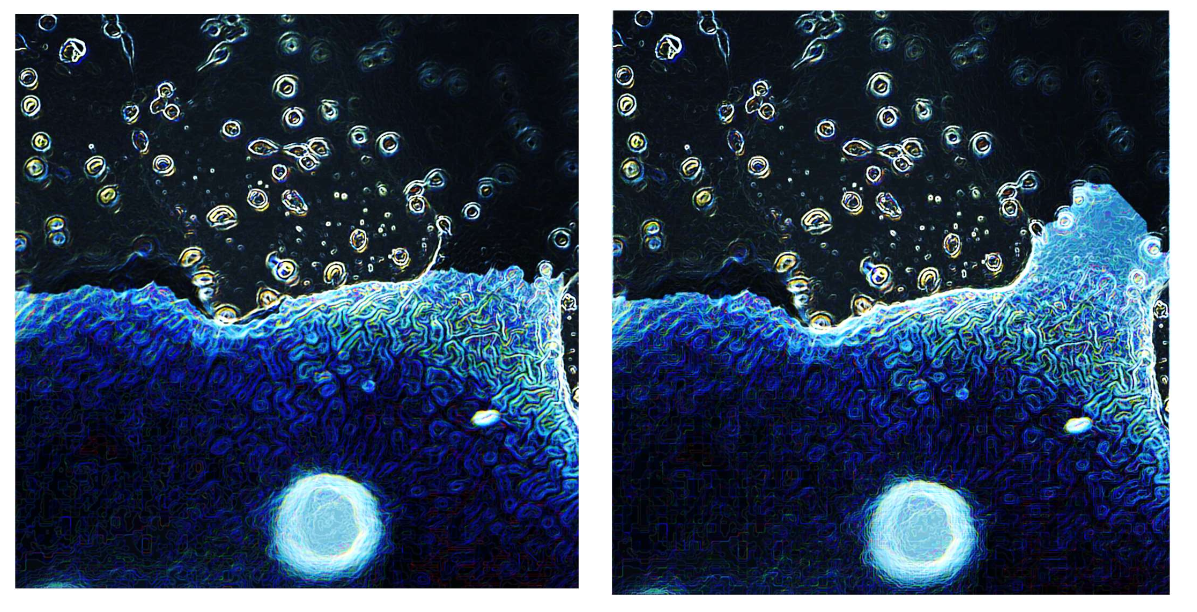Novel ‘Scaffolding’ Biomaterial Improves Bladder Regeneration and Function

The image shows a conductive scaffold that is functionalized with PEDOT (poly(3,4-ethylenedioxythiophene)) conductive polymer. Biological cells are shown above the material with the different colors depicting modified cellular activity due to the changing cellular environment. Courtesy of Rebecca Keate, PhD.
A team of Northwestern scientists has developed an electroactive “scaffolding” material that improves bladder tissue regeneration and organ function better than current techniques, as detailed in a recent study published in Nature Communications.
The novel biomaterial could improve outcomes in patients with impaired bladder function with minimal side effects and also reduce the need for additional high-risk surgical procedures, according to Guillermo A. Ameer, ScD, professor of Surgery in the Division of Vascular Surgery and the Daniel Hale Williams Professor of Biomedical Engineering in the McCormick School of Engineering, who was senior author of the study.
Guillermo A. Ameer, ScD, professor of Surgery in the Division of Vascular Surgery and the Daniel Hale Williams Professor of Biomedical Engineering in the McCormick School of Engineering, was senior author of the study published in Nature Communications.
“This might be the first example of a cell-free electrically conductive device regenerating an organ,” Ameer said. “The use of cell-seeded materials often complicates manufacturing and clinical implementation, yet materials without cells commonly do not perform well enough for successful translation to patients. Here, we demonstrate that integrating electrically conductive components into a biodegradable elastomer can lead to a manufacturable material that produces biological and functional results that are on par with the gold standard.”
Historically, tissue engineering has relied on utilizing cell-seeded scaffolds, which involves taking tissue cells from a biopsy, growing the cells on a scaffold-like material and then implanting that scaffold into a specific organ.
Bladder tissue regeneration or augmentation specifically is needed to address neurogenerative diseases in which bladder control and function have become impaired, as well as in cancer.
Previous work has shown that cell-seeded citrate-based scaffolds for bladder regeneration demonstrated safety for long-term applications. However, there has remained a need for cell-free biomaterials that are more robust and cost-efficient to manufacture, according to Ameer.
“Incorporating conductive polymers into non-conductive materials can significantly alter their mechanical properties, for example making them brittle, which complicates their implementation in dynamic systems such as the bladder,” Ameer said.
Using an advanced technique called plasticizing functionalization, the investigators designed and developed an electrically conductive scaffold biomaterial that could better support bladder tissue regeneration than current methods.
“It’s electroactive and has ionic conductivity capability, which is more similar to what we have in our bodies,” Ameer said.
To demonstrate the efficacy of this electroactive scaffold in bladder tissue regeneration, the team utilized animal models of impaired bladder function. They found that the scaffold restored the animals’ tissue regeneration and bladder function better than the cell-containing material.
The scientists’ next steps, according to Ameer, will be analyzing their electrically conductive scaffold in a long-term animal model to better understand how scaffold function is impacted as it degrades in the organ tissue.
“This is truly an off-the-shelf strategy where you could, for example, package the device and open it in the surgery suite and perform reconstruction with no issues of having to deal with cells and the source of those cells,” Ameer said. “It can make the entire process a lot easier.”
“I am excited for this work because I think it puts the true potential of electronic materials on display. The ability to regenerate functional tissue without adding any supplemental stimulation or biological components means that we are closer to designing solutions that reach the clinic and actually help patients that need better technologies,” said Rebecca Keate, PhD, a postdoctoral fellow at Northwestern’s Center for Advanced Regenerative Engineering and lead author of the study.
Arun Sharma, PhD, research associate professor of Urology in the Division of Pediatric Urology, and Jonathan Rivnay, PhD, professor of Biomedical Engineering at McCormick, were co-authors of the study.
This work supported by National Institutes of Health awards R01EB026572 and R01DK109539, the Michelon Family, the National Institutes of Health Training grant T32GM008449 through Northwestern University’s Biotechnology Training Program, the Ryan Fellowship and the International Institute for Nanotechnology at Northwestern University.
View the original press release here.


